South Asian Free Trade Agreement (SAFTA): Issues and Implications
South Asian Free Trade Agreement (SAFTA): Issues and Implications. Presented By: Mohammad Muaz Jalil, Senior Researcher and Trade Specialist, I-PAG. Cost of Economic Non Cooperation to Consumers in South Asia COENCOSA. Project Review Meeting Dhaka, June 28, 2011.
Share Presentation
Embed Code
Link
Download Presentation
- standard gravity model
- south asia
- rta south asian association
- multilateral resistance
- total import trade
- full employment

shen + Follow
Download Presentation
South Asian Free Trade Agreement (SAFTA): Issues and Implications
An Image/Link below is provided (as is) to download presentation Download Policy: Content on the Website is provided to you AS IS for your information and personal use and may not be sold / licensed / shared on other websites without getting consent from its author. Content is provided to you AS IS for your information and personal use only. Download presentation by click this link. While downloading, if for some reason you are not able to download a presentation, the publisher may have deleted the file from their server. During download, if you can't get a presentation, the file might be deleted by the publisher.
Presentation Transcript
- South Asian Free Trade Agreement (SAFTA): Issues and Implications Presented By: Mohammad Muaz Jalil, Senior Researcher and Trade Specialist, I-PAG Cost of Economic Non Cooperation to Consumers in South Asia COENCOSA Project Review MeetingDhaka, June 28, 2011
- The large majority of the WTO Members are party to one or more RTAs. As of January 2005, the WTO had been notified of 312 RTA South Asian Association for Regional Cooperation (SAARC) was established in 1985 In 70s and 80s, Inward-oriented development strategy, highly regulated financial, fiscal and industrial policy, anti-export bias Geared more towards import substitution rather than export led development Countries faced poor economic performance which provided incentive for liberalization (Sri Lanka liberalized in 70s) Background
- The objectives of the treaty are sought to be achieved in the following ways: Eliminating barriers to trade and facilitating cross-border movement of goods Promoting conditions of fair competition and ensuring equitable benefits, taking into account their respective levels and patterns of economic development Creating effective mechanisms for the implementation and application of the agreement, for its joint administration and the resolution of disputes Establishing a framework for further regional cooperation to expand and enhance mutual benefits. Background
- South Asian Preferential Trade Arrangement (SAPTA) signed in 1995 to promote trade and economic cooperation Slow progress of SAPTA as it did not increase the volume of intra-regional trade and investment flows SAFTA more ambitious than SAPTA, the agreement entered into 2006, with the provisions of its Trade Liberalization Program scheduled to be fully implemented by 2016 SAFTA has six core elements: Trade liberalization programme; Sensitive lists; Rules of origin; Non-tariff & para-tariff barriers; Revenue compensation mechanism and Technical assistance for LDCs Agreement also allows for safeguard measures, allows partial or full withdrawal of preference SAFTA and SAPTA
- Several analyses of regional free trade in South Asia have demonstrated minimal gains from trade expansion and unequal benefit For intra-regional trade to expand it is important that the trade profiles of the countries match Trade profile more aligned, intra-regional trade in South Asia has a potential to increase substantially. Impact of South Asian Free Trade Area (SAFTA)
- Between 1995 and 2005, intra-regional trade in South Asia hovered around 5% of total trade of these countries. Trade ranged between 20-60% in the case of many other regional economic blocs The net result of this economic non-cooperation among the SAARC countries is high costs to consumers It is estimated that trade between India and Pakistan could have been 70% more than what it is today! Impact of South Asian Free Trade Area (SAFTA)
- It is estimated that almost 53% of the total import trade in SAFTA members has been subject to the negative lists of the respective countries Seriously inhibit intra-regional trade as well as significant reduction of consumer welfare Barriers to Trade : Sensitive List
- India’s total imports from Bangladesh during the period 2005-06 were US$127.03mn Top 20 items that were imported from Bangladesh amounted to US$60.16mn Of these 10 items which are in India’s sensitive list for LDCs under SAFTA,( constitutes 7.28 %of the total imports from Bangladesh) Implies substantial market access for Bangladesh under SAFTA. Over 70% of Bangladesh’s export includes mainly items of textiles & textile materials, and shrimp. Out of Bangladesh’s top 50 export items, 31 items are in India’s sensitive list for SAFTA LDCs Barriers to Trade : Sensitive List
- Very little research has been done in this area; primary focus of most research has been on producer surplus. Primary focus on producer surplus, trade creation trade diversion, cost minimization, least-cost suppliers Redefining in terms of maximizing consumer surplus Most common theoretical tool used : Computable General Equilibrium (CGE) models and gravity models Applied Research on SAFTA : Issues
- CGE models often have several key driving forces that originate in their social accounting matrix data base, algebraic structure and parameter assumptions, Whose influence on the model’s results remain hidden and open to misattribution. Restrictive assumptions : full employment, all firms earn zero profits, all households are on their budget constraint May fail to incorporate the trading arrangement characteristics like RoO, and new products that become tradable following an FTA Only passing references are made to consumer welfare gains/loss in such exercises. Applied Research on SAFTA : CGE
- Standard gravity model predicts bilateral trade flows based on the economics sizes (GDP) and the (economic) distance McCallum (1995): dummy variable if traded goods crossed a provincial border (intra-US, intra-Canada trade Anderson and Wincoop (2003) specification: Multilateral Resistance term, otherwise omitted variable bias Border effects have an asymmetric effect on countries of different size: they have a larger effect on small countries. The more resistant a country is to trade with all other countries, the more it is pushed to trade with a given bilateral partner Applied Research on SAFTA : Gravity Model
- Evans (2003) : Differences in international and national transaction costs and Policy-related barriers explained a significant part of the border effect Effects of language, national networks, and social capital on transaction cost very high Geographical proximity has not translated into lower transport or transactions costs for the SAARC countries (NTBs and Para tariff) Para-tariffs : these charges are levied to bring import prices at par with domestic pricesbut usually overcompensates Greater integration and tariff reduction in Sensitive list may not increase consumer welfare Barriers to Trade : Beyond Borders
- Strong need for conducting research on evaluating the impact of SAFTA on Consumer welfare Need for identifying key policy and structural bottlenecks Perception based survey may yield valuable and insightful information however there might be perception bias: Dreze and Sen (2002) showed that the incidence of reported morbidity was higher in Kerala than in Bihar, a poorer state with considerably higher mortality Way Forward
- Thank You

Freedom of the Air
About the right accorded to airlines with the countries trade agreement.
3.22k views • 14 slides
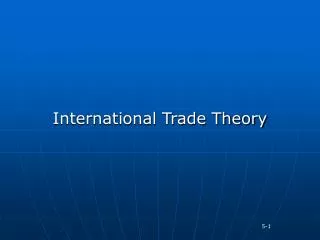
International Trade Theory
International Trade Theory. 5-1. Chapter Objectives. Explain trade theories Discuss how global efficiency can be increased through free trade Introduce prescriptions for altering trade patterns Explore how business decisions influence international trade. 5-2. International Trade.
1.28k views • 47 slides
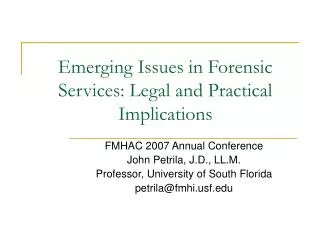
Emerging Issues in Forensic Services: Legal and Practical Implications
Emerging Issues in Forensic Services: Legal and Practical Implications. FMHAC 2007 Annual Conference John Petrila, J.D., LL.M. Professor, University of South Florida petrila@fmhi.usf.edu. Context Then and Now. The major forensic issues 25 years ago Competency to stand trial
918 views • 65 slides
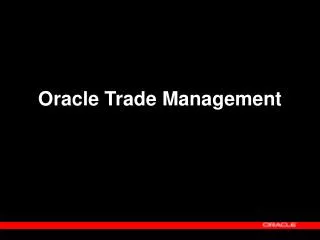
Oracle Trade Management
Oracle Trade Management. Agenda. Oracle Trade Management Overview Customer Success Roadmap. Oracle Trade Management Overview. The Business of Trade Management. Establishing Quotas. Allocating Budgets. Understanding The Impact. Resolving Customer Issues. Account Planning.
1.23k views • 40 slides
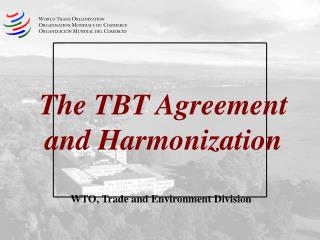
The TBT Agreement and Harmonization
The TBT Agreement and Harmonization. WTO, Trade and Environment Division. Philosophy of the TBT Agreement. Stated Preference for. International Standards. International Conformity Assessment Procedures. The Preamble of the TBT Agreement. Development of International Standards is Encouraged.
852 views • 70 slides
 Free Trade Areas Chapter 10" width="320px" />
Free Trade Areas Chapter 10" width="320px" />
Economic Integration: Customs Union and Free Trade Areas Chapter 10
Economic Integration: Customs Union and Free Trade Areas Chapter 10. 1 Introduction. Examine economic integration in general and customs unions in particular Discuss the trade-creating customs union, trade-diverting customs union and the dynamic effects of customs unions
1.08k views • 36 slides
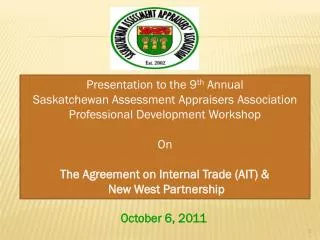
October 6, 2011
October 6, 2011. Presentation to the 9 th Annual Saskatchewan Assessment Appraisers Association Professional Development Workshop On The Agreement on Internal Trade (AIT) & New West Partnership. The Agreement on Internal Trade (AIT) & New West Partnership.
1.08k views • 95 slides

World TRADE ORGANIZATION & Agreement on internal trade
World TRADE ORGANIZATION & Agreement on internal trade. Karlee, Madison, Jillian, Lauren. World Trade Organization. Main Objective. Mission Statement: “The World Trade Organization- the WTO- is the international organization whose primary purpose is to open trade for the benefit of all.”
930 views • 18 slides

Chapter 11
Chapter 11. Industry. By Eugene Stanton. Industrial Power Shift . The recent success of Japan, South Korea, Taiwan, and other Asian countries is a dramatic change from the historic dominance of world industry by Western countries. Key Issues. Where did industry originate?
881 views • 77 slides

Chapters 20,21,22: Africa and the Slave Trade, the Gunpowder Empires, and Asian Changes, 1450-1750
Chapters 20,21,22: Africa and the Slave Trade, the Gunpowder Empires, and Asian Changes, 1450-1750. Mr. Bartula AP World History. Africa: 1450-1750. No longer aligned with the Islamic world trading system Forceably brought into the Atlantic trading system Heterogeneous societies and cultures.
1.14k views • 95 slides

Using Non-compete Agreements to Protect Trade Secrets
Using Non-compete Agreements to Protect Trade Secrets. Victoria A. Cundiff Paul, Hastings, Janofsky & Walker LLP New York, New York. 1. Trade Secrets Law is Becoming Increasingly Important. Economic concerns--trade secrets protection is not free, but may have lower up-front costs
823 views • 50 slides
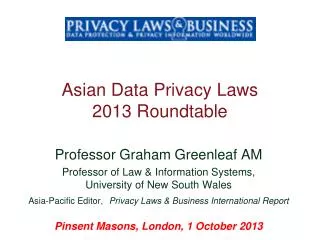
Asian Data Privacy Laws 2013 Roundtable
Asian Data Privacy Laws 2013 Roundtable. Professor Graham Greenleaf AM Professor of Law & Information Systems, University of New South Wales Asia -Pacific Editor, Privacy Laws & Business International Report Pinsent Masons, London, 1 October 2013.
1.42k views • 126 slides
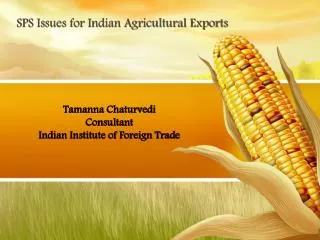
Tamanna Chaturvedi Consultant Indian Institute of Foreign Trade
Tamanna Chaturvedi Consultant Indian Institute of Foreign Trade. SPS Issues for Indian Agricultural Exports. NTBs. %. tariffs. ?. 1947. 2009. Two Way Dilemma. WTO Agreement on Sanitary and Phyto Sanitary Measures. WTO Agreement on Sanitary and Phyto Sanitary Measures.
1.06k views • 72 slides
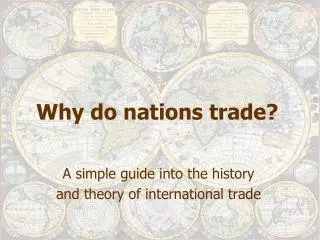
Why do nations trade?
Why do nations trade?. A simple guide into the history and theory of international trade. What will I talk about?. Links between the history and the theories of international trade Most important trade theories and their implications. You won’t see:. Complex math Complex charts.
931 views • 56 slides

Who are New Zealand’s Asian People?
Psychosomatic symptoms in Asian populations: more than a headache? Presentation by Dr. Gen Numaguchi, Ph.D. WCMHT – Queenstown Southern DHB. Who are New Zealand’s Asian People?.
788 views • 69 slides

Trade and Health
Ronald Labonté Canada Research Chair, Globalization/Health Equity University of Ottawa. Trade and Health. To trade or not to trade?. That is not the question! Trade endemic to human societies, global trade as old as human settlements What changes is our notion of ‘global’ The questions:
1.38k views • 80 slides
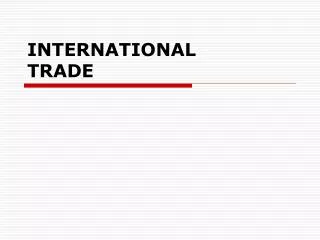
INTERNATIONAL TRADE
INTERNATIONAL TRADE. INTERNATIONAL TRADE. GLOBAL TRADE, WORLD TRADE, FOREIGN TRADE, REGIONAL TRADE vs. HOME TRADE, LOCAL TRADE, DOMESTIC TRADE, INWARD TRADE. EXPORTING AND IMPORTING (NOUNS AND VERBS). EXPORTER / IMPORTER
1.16k views • 18 slides
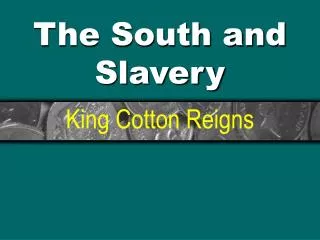
The South and Slavery
The South and Slavery. King Cotton Reigns. The Cotton Kingdom. Post Revolutionary recession results in decline in slavery Ideals of the Revolution conflict with slavery. Some owners free their slaves. Slavery Expands and Cotton Become King. Cotton Gin Trade
884 views • 33 slides

Arbitration Agreement . Drafting Arbitration Agreement
International Commercial Arbitration. Arbitration Agreement . Drafting Arbitration Agreement. Arbitration Agreement. “A poorly drafted dispute resolution clause is worse than no clause at all.” ICDR Guide to Drafting Dispute Resolution Clauses. Arbitration Agreement.
1.5k views • 68 slides

PASLA/RMA CONFERENCE Global Legal and Regulatory Issues and Business Implications
PASLA/RMA CONFERENCE Global Legal and Regulatory Issues and Business Implications. Gregory J. Lyons. March 6, 2014. Indemnified Securities Lending What Frameworks Are Relevant?. Basel Committee. Dodd-Frank. Lender Disclosure. Future Capital. Capital SCCL Lending Limits FBO Rules.
1.11k views • 96 slides
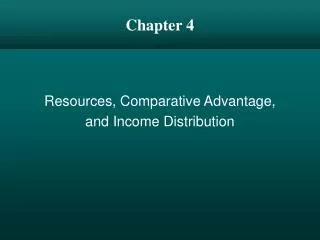
Chapter 4
Chapter 4. Resources, Comparative Advantage, and Income Distribution. Outline. 1 .A Model of Two-Factor Economy 2 .Effects of International Trade Between Two-Factor Economies Case Study: North South Trade and Income Inequality 3 .The Political Economy of Trade: A Preliminary View
1.06k views • 80 slides
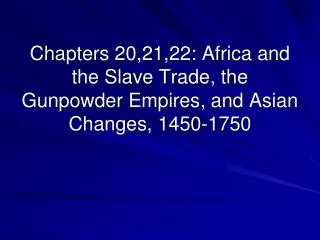
Chapters 20,21,22: Africa and the Slave Trade, the Gunpowder Empires, and Asian Changes, 1450-1750
Chapters 20,21,22: Africa and the Slave Trade, the Gunpowder Empires, and Asian Changes, 1450-1750. Africa: 1450-1750. No longer aligned with the Islamic world trading system Forceably brought into the Atlantic trading system Heterogeneous societies and cultures. The Empire of Mali.
1.24k views • 95 slides








 Free Trade Areas Chapter 10" width="320px" />
Free Trade Areas Chapter 10" width="320px" />














